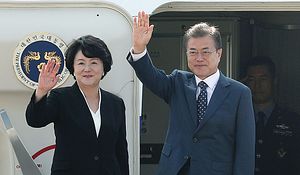As of this week, South Korean President Moon Jae-in has officially entered the second half of his five-year term. Moon has laid the groundwork of his ambitious policy agenda, yet plenty of work still lies ahead to fulfill campaign pledges and tackle new challenges that have emerged since he took office.
The key domestic issue of Moon’s presidency has been promoting inclusive economic growth. Moon’s initial economic plan was centered around three pillars: public sector-led job creation, expansion of the social safety net, and reforming the chaebol – South Korea’s large multinational corporations. Toward these ends, he has so far created over 90,000 public sector jobs – 63,000 jobs in 2017, 9,475 in 2018, and 18,000 in 2019 – dramatically increased welfare spending, and called on the National Pension Service to more actively leverage its shares in the chaebol to better serve the interests of South Korean workers. In one of the world’s most overworked countries, Moon also lowered the maximum workweek from 68 to 52 hours and increased the minimum wage from 6,470 won ($5.70) per hour at the start of 2017 to 8,350 won per hour ($7.37) set for next year.
While Moon has been successful politically in addressing these campaign issues, the results have been more mixed. In 2017, South Korea’s GDP grew by 3.1 percent, but various estimates for growth this year range from 2 to 2.5 percent. External economic forces are a big factor in this slump, but critics also place the blame on Moon. Minimum wage hikes, which have outpaced productivity, have adversely impacted small businesses owners and employment prospects for young South Koreans. Even though the country’s jobless rate is at a six-year low, there are concerns that current figures are overstated by new government jobs and paper over troubling trends, such as job losses in manufacturing, a key sector for economic growth.
The Blue House has nevertheless stressed the need to stick to its current path amid calls for a change in direction from detractors. Next year’s proposed government budget is 9.3 percent larger than this year’s, with more spending promised to advance Fourth Industrial Revolution industries such as biotech and 5G.
Moon, however, is fast approaching a watershed moment in his presidency that could serve as a referendum on his economic agenda: the 2020 National Assembly elections. Though much can change between now and next April, recent polling suggests the state of the economy is working against him. In an October Gallup Korea poll, only 39 percent of people surveyed approved of the president. The most cited reason among those who oppose Moon, at 25 percent, was his handling of the economy, while only 2 percent of those backing Moon claimed it was the biggest factor in their support. Should Moon’s Democratic Party shed seats in the election, it will make staying the course more difficult.
On foreign policy, Moon has been most heavily invested in resolving the North Korea issue. The bellicosity between Pyongyang and Washington that characterized his first year in office has since given way to diplomatic overtures, yet Moon has been unable to push forward with much of his engagement plans. The Blue House has still made some progress, such as the opening of a joint liaison office at the Kaesong Industrial Complex and the Comprehensive Military Agreement, but without progress in U.S.-North Korea talks, engagement efforts will continue to be severely constrained. Moon was an important player helping to keep these talks alive through the Trump-Kim summit in February, but North Korean leadership has since tried to hold Moon at a distance. Though now playing a diminished role, Moon has doubled down on reaching a resolution to the North Korea issue by asserting that inter-Korean peace will jumpstart the struggling economy.
North Korea’s end-of-year deadline for talks with the United States will likely determine the way forward for Moon’s inter-Korean efforts early on in the second half of his term. Should Pyongyang and Washington continue to be at an impasse by December 31, Kim Jong Un could eschew negotiations altogether, taking the wind out of Moon’s sails. The Blue House may try to help move talks along by proposing a new North Korea-centered development bank at the upcoming ASEAN-Republic of Korea Commemorative Summit – otherwise reinforcing Moon’s New Southern Policy – though this seems unlikely to substantively provide much-needed momentum.
As is the nature of foreign policy, Moon is also charged with managing new issues that have developed over the course of his tenure. Difficult military burden-sharing negotiations with the U.S., a contentious historical dispute with Japan that has spilled over into bilateral economic ties, and being caught in the middle of a trade war between Washington and Beijing are all unlikely to be easily resolved.
If the first 30 months of Moon’s time in office were devised to set his policies up for success, then the next 30 months is where the administration will be expected to deliver, despite forces beyond its control not working in its favor.
Kyle Ferrier is a Fellow and Director of Academic Affairs at the Korea Economic Institute of America (KEI) and a contributor to The Diplomat’s Koreas blog.
































